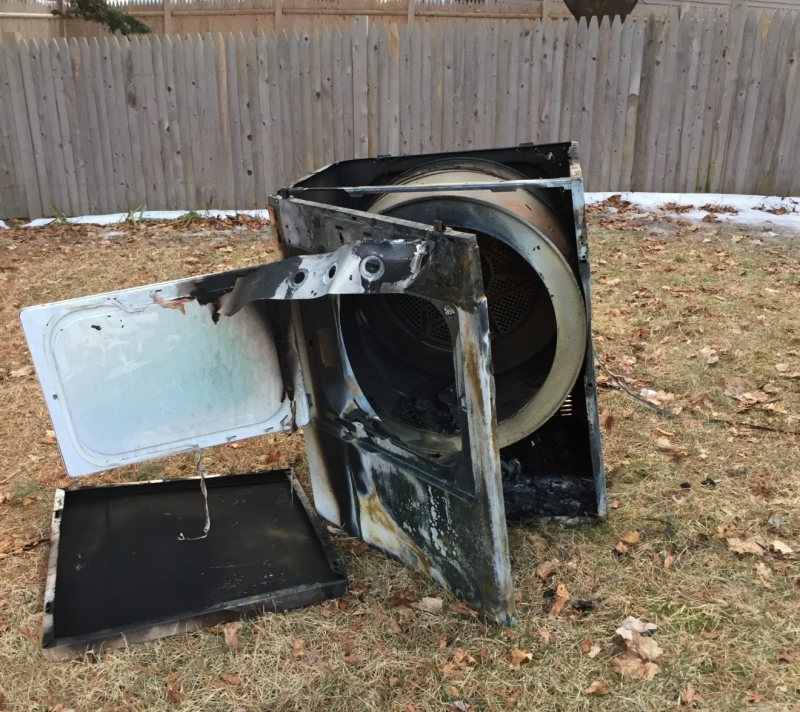
ROCHESTER - Dryer fires are responsible for nine deaths, 420 injuries, and $222 million in property damage annually, according to National Fire Protection Association figures, so when Rochester Fire Chief Mark Klose saw his department respond to two such fires within one week, he took the opportunity to apprise the public of the dangers they pose.
Both fires were quickly doused thanks to working smoke alarms in both buildings.
Fires at homes on Hunter Court and Joshua Street both began inside the homes' dryers, which caused smoke damage and minor structural damage. A third fire at a home on River Street ignited in a light fixture but was also contained quickly.
"All three of these fires were caught early and extinguished because these homes had working smoke alarms," Klose said. "Each one should serve as a reminder of the importance of testing your smoke and carbon monoxide alarms, as they can make all the difference in preventing a tragedy caused by fire."
Klose also urged the public to regularly clean lint from their dryers and vent hose, which can reduce the risk of dryer fires like the ones Rochester Firefighters responded to last week.
He also encourages residents to ensure they have working carbon monoxide detectors following the deaths of two people in Lyman last week from CO poisoning.
The National Fire Protection Association (NFPA) reports that 46 percent of smoke alarms that failed to operate had missing, disconnected or dead batteries and roughly three out of every five fire deaths occur in homes with no working smoke alarms.
In order to keep your home safe and prevent fires, the Rochester Fire Department recommends that residents follow safety tips outlined by NFPA:
Test smoke and carbon monoxide alarms at least once a month using the test button. Replace alarms immediately if they don't respond properly when tested.
Replace batteries in smoke and CO alarms when you change your clocks.
Replace all smoke alarms when they reach 10 years old. Replace CO detectors according to the manufacturer's instructions.
CO alarms should be installed in a central location outside each sleeping area, on every level of the home, and in other locations where required by applicable laws, codes or standards. For the best protection, interconnect all CO alarms throughout the home. When one sounds, they all sound.
If the CO alarm sounds, immediately move to a fresh air location outdoors or by an open window or door. Make sure everyone inside the home is accounted for. Call for help from a fresh air location and stay in that spot until emergency personnel arrive.
Meanwhile, below is a list of safeguards put together by Consumer Reports to keep dryer fires from ever happening.
- Clean the Lint Filter
Not once a month, or even once a week: "Clean the lint from the dryer's lint screen after every load," says Richard Handel, the test engineer who oversees CR's laundry appliance lab. "This helps prevent a fire, and it also helps your laundry dry faster."
- Replace Accordion-Style Ducts
Generally, dryers are equipped with a 4-inch vent in the back, which homeowners or installers connect to the exterior vent with a duct. But not all ducts will do.
If you see a plastic or foil accordion-style duct connecting your appliance to the vent, it's a good idea to replace it. These are risky because they can sag, allowing lint to build up at low points and trapping lint in their ridges.
Handel recommends a rigid metal duct. "The smooth walls allow the air to flow, and also reduce the buildup of lint," he says. "A flexible metal duct should be your second choice."
One other tip: Use duct connectors and metal clamps or foil tape to join sections of duct rather than sheet-metal screws, which can catch lint and cause buildup inside the duct.
- Clean the Dryer Duct Annually (at Least)
If you notice that your dryer takes longer to dry laundry than it used to, that's a clue that there may be a blockage in the dryer vent system. When you're drying a load, go outside and look at the vent. Do you see or feel exhaust air? If not, the vent or exhaust duct may be blocked with lint.
Start by disconnecting your dryer from the power source. And if you have a gas dryer, also turn off the gas valve near the dryer.
"Carefully slide the dryer away from the wall so that you can access the vent that's typically in the back of the dryer," says Handel. "If you have a gas dryer, take care not to overstretch or damage the gas line."
Disconnect the duct from the dryer, and vacuum both the dryer and the duct--as much as you can access. Where possible, separate the duct into shorter sections for better access, then reassemble and attach the duct to the dryer. Be sure all joints in the duct are properly connected and held together with clamps or foil tape. Then return the dryer to its original spot and reconnect the power.
While you're at it, clean behind the dryer and underneath it--lint builds up there, too. In winter, check after windy weather or snowstorms to be sure that snow isn't blocking the outdoor vent.
- Handle Chemical Stains With Care
Clothes stained with gas, cooking oil, cleaning agents, or other flammable chemicals or substances need special care. The Consumer Product Safety Commission recommends washing such stained clothing more than once to minimize volatile chemicals, then hanging to dry.
If you must use a dryer, use the lowest heat setting and a drying cycle that concludes with a cool-down period.
In the event that a fire does start, keep the dryer door closed to limit its oxygen supply--a fire needs oxygen to keep it going.












